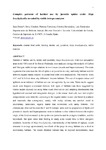Complex patterns of habitat use by spider crabs Maja squinado revealed by stable isotope analyses

View/
Use this link to cite
http://hdl.handle.net/2183/138Collections
- Investigación (FCIE) [1228]
Metadata
Show full item recordTitle
Complex patterns of habitat use by spider crabs Maja squinado revealed by stable isotope analysesAuthor(s)
Date
2005Abstract
[Abstract] Patterns of habitat use by spider crab juveniles, Maja brachydactila, from two geographic areas in the NW coast of the Iberian Peninsula, were analyzed through the analysis of Carbon and Nitrogen stable isotope relations in two tissues (muscle and hepatopancreas). The main
organisms that constitute the diet of spider crab juveniles in rocky and sandy habitats and the
different organic matter sources in coastal food webs were analysed too. The isotopic ratios of C and N did not show any difference between habitats. The use of carapace colour and
epibiosis as an indicator of habitat use was not supported by our data. These results suggest
much more frequent movements between both types of habitats than those suggested by
former studies (carried out using behavioural observations and sampling distributions) that
hypothesized seasonal and ontogenetic changes. In the coastal food web, two main trophic
compartments were identified according to the organic matter source: one based in plankton
and seaweeds, that corresponds, mainly, with rocky habitats, and another based in
sedimentary particulated organic matter that correspond with sandy bottoms. The
relationships observed between the C and N isotopic ratios and the proportions of lipids and
proteins in muscle and hepatopancreas seem to indicate a clear relation between the trophic
origin of the food consumed by the spider crab juveniles and its energetic condition, and the
individuals that spent more time feeding in sandy areas would show a better energetic
condition. Juveniles of Maja brachydactila, independently of the habitat of capture, would
consume in average approximately two thirds of the preys in rocky habitats and a third in
sedimentary habitats. The results obtained indicate that, in exposed environments, large juveniles spend most of the time in sedimentary bottoms, where they find more refuge, but
they move frequently (probably at night) to the nearby rocky substrates to feed.
Keywords
Habitat use





